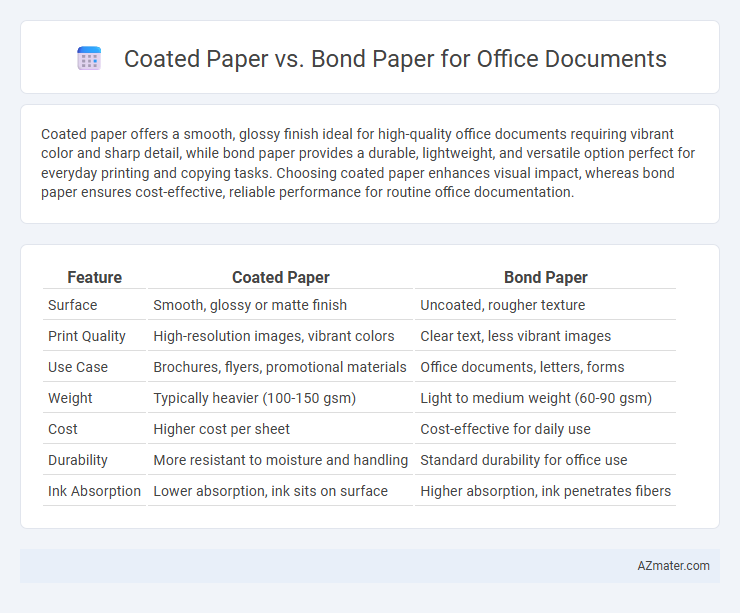Coated paper offers a smooth, glossy finish ideal for high-quality office documents requiring vibrant color and sharp detail, while bond paper provides a durable, lightweight, and versatile option perfect for everyday printing and copying tasks. Choosing coated paper enhances visual impact, whereas bond paper ensures cost-effective, reliable performance for routine office documentation.
Table of Comparison
| Feature | Coated Paper | Bond Paper |
|---|---|---|
| Surface | Smooth, glossy or matte finish | Uncoated, rougher texture |
| Print Quality | High-resolution images, vibrant colors | Clear text, less vibrant images |
| Use Case | Brochures, flyers, promotional materials | Office documents, letters, forms |
| Weight | Typically heavier (100-150 gsm) | Light to medium weight (60-90 gsm) |
| Cost | Higher cost per sheet | Cost-effective for daily use |
| Durability | More resistant to moisture and handling | Standard durability for office use |
| Ink Absorption | Lower absorption, ink sits on surface | Higher absorption, ink penetrates fibers |
Introduction to Coated and Bond Paper
Coated paper features a smooth surface treated with a layer of glossy or matte coating to enhance image sharpness and color vibrancy, making it ideal for high-quality office reports and presentations. Bond paper is uncoated, durable, and designed for everyday printing tasks such as letters, memos, and official documents, offering better ink absorption and writing compatibility. Choosing between coated and bond paper depends on the intended use, with coated paper excelling in visual appeal and bond paper providing practicality and cost efficiency.
Defining Coated Paper: Features and Benefits
Coated paper features a smooth surface achieved by applying a layer of clay or polymer, enhancing print sharpness and color vibrancy for office documents. Its glossy or matte finish improves image quality, making it ideal for presentation materials and marketing brochures. The coated surface also offers better durability and resistance to dirt and moisture compared to uncoated bond paper.
What is Bond Paper? Key Characteristics
Bond paper is a high-quality, durable paper commonly used for office documents, letterheads, and forms, known for its strength and smooth texture. It is typically made from cotton fibers or a blend of cotton and wood pulp, providing excellent ink absorption and resistance to tearing. Its key characteristics include a weight range of 16 to 24 pounds, a bright white finish, and a slightly rough surface that enhances print clarity and professional appearance.
Visual Differences: Texture and Finish
Coated paper features a smooth, glossy or matte finish that enhances color vibrancy and sharpness, making it ideal for high-quality office presentations and marketing materials. Bond paper has a more textured, uncoated surface, offering a matte appearance that is better suited for everyday printing and writing tasks where readability and ink absorption are key. The choice between coated and bond paper greatly impacts the visual appeal and tactile experience of office documents.
Print Quality: Graphics, Text, and Colors
Coated paper offers superior print quality for office documents, enhancing graphics, text sharpness, and vibrant color reproduction due to its smooth, sealed surface that prevents ink absorption. Bond paper, while ideal for everyday printing, provides a matte finish with less color saturation and detail precision, making it less suitable for high-resolution graphics and vibrant colors. For presentations or marketing materials requiring crisp images and vivid hues, coated paper significantly outperforms bond paper in maintaining print clarity and color fidelity.
Durability and Handling
Coated paper features a smooth, sealed surface that offers enhanced durability and resistance to smudging, making it ideal for high-quality office documents that require a professional finish. Bond paper, known for its fibrous texture and strength, provides excellent handling and durability for everyday office use, particularly for documents that undergo frequent handling or printing. Choosing coated paper improves visual appeal and moisture resistance, while bond paper ensures reliable performance and easy writing or copying.
Cost Comparison: Which is More Affordable?
Coated paper generally costs more than bond paper due to its glossy finish and higher production expenses, making bond paper the more economical choice for everyday office documents. Bond paper, designed for durability and ease of writing, offers affordability without sacrificing quality, ideal for bulk printing and standard office use. For cost-conscious businesses, selecting bond paper reduces overall printing expenses while maintaining professional document presentation.
Environmental Considerations
Coated paper typically involves a higher environmental footprint due to its production process, which includes chemical coatings and increased energy use, leading to more difficult recycling compared to bond paper. Bond paper, often made from uncoated, recycled fibers, offers a more eco-friendly option with better recyclability and reduced chemical pollution. Choosing bond paper for office documents aligns with sustainable practices by minimizing waste and supporting circular economy principles.
Best Use Cases in Office Settings
Coated paper offers a smooth, glossy finish ideal for high-quality presentations, marketing materials, and color-rich documents that require sharp images and vibrant colors in office settings. Bond paper, known for its durability and opacity, is best suited for everyday office documents such as memos, reports, and letterheads where cost-efficiency and readability are priorities. Choosing coated paper enhances visual appeal for client-facing documents, while bond paper supports frequent printing and writing tasks in administrative use.
Choosing the Right Paper for Your Document Needs
Coated paper offers a smooth, glossy surface that enhances color vibrancy, making it ideal for presentations, brochures, and reports requiring high-quality visuals. Bond paper provides a more porous, matte finish and is better suited for everyday office documents like letters and memos due to its durability and cost-effectiveness. Selecting between coated and bond paper depends on the document purpose: prioritize coated paper for visual impact and bond paper for professional, routine printing tasks.

Infographic: Coated paper vs Bond paper for Office Document
 azmater.com
azmater.com